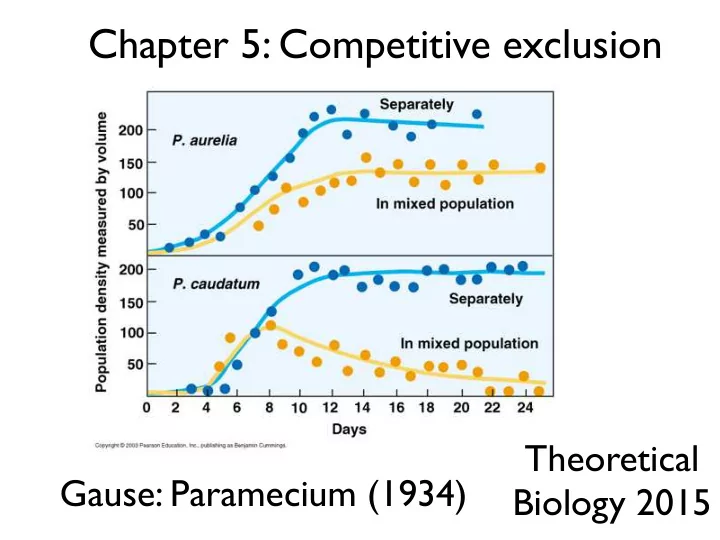

Chapter 5: Competitive exclusion Theoretical Gause: Paramecium (1934) Biology 2015
Competitive exclusion Tilman 1981 Two species of diatom feeding on silica: Af: Asterionella formosa Su: Synedra ulna , Si: silica From: Smith & Smith, Elements of Ecology
Question 6.5 on immune responses d T d I d t = σ − δ T T − β TI , d t = β TI − δ I I − k 1 IE 1 − k 2 IE 2 , d E 1 d E 2 d t = α 1 E 1 I − δ E E 1 and d t = α 2 E 2 I − δ E E 2 . dE./dt gives: I= δ E / α 1 and I= δ E / α 2 . E 1 and E 2 have to be solved from dI/dt=0. Substitute I= δ E / α 1 into dE 2 /dt: d E 2 = δ E E 2 ( α 2 / α 1 − 1) < 0 d t
Simplest mathematical model Resource (e.g., amount of nitrogen available): R = 1 − N 1 − N 2 Two consumers dN 1 dN 2 = N 1 ( b 1 R − d 1 ) and = N 2 ( b 2 R − d 2 ) dt dt With a fitness of R 0 1 = b 1 /d 1 R 0 2 = b 2 /d 2 and
Nullclines Substitution of R = 1 − N 1 − N 2 into d N 1 = N 1 ( b 1 R − d 1 ) d t yields d N 1 = N 1 ( b 1 (1 − N 1 − N 2 ) − d 1 ) d t which has nullclines N 1 = 0 and 1 N 2 = 1 − − N 1 R 0 1
1 − 1 Nullclines R 0 N 2 1 − 1 N 1 R 0 Similarly the d N 2 / d t = 0 nullcline is found to be 1 N 2 = 1 − − N 1 R 0 2 Thus, plotting N 2 as a function of N 1 the two nullclines run parallel with slope − 1.
Paradox of the plankton, bacteria in the gut, ... How can so many species co-exist? co-existence not an equilibrium? Space is not homogeneous? Species are so similar that exclusion is slow? Species are largely controlled by parasites?
Recommend
More recommend